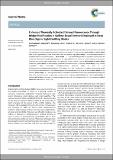Enhanced thermally activated delayed fluorescence through bridge modification in sulfone-based emitters employed in deep blue organic light-emitting diodes
View/
Date
14/06/2019Author
Grant ID
EP/P010482/1
EP/R035164/1
749557
EP/P010482/1
Metadata
Show full item recordAbstract
Two thermally activated delayed fluorescence (TADF) emitters bearing a new dipyridyl sulfone core as the electron-accepting unit and di-tert-butyl carbazoles as electron-donating units are reported. The two emitters, pDTCz-2DPyS and pDTCz-3DPyS , differ in the regiochemistry of the substitution about the pyridine rings [ pDTCz-2DPyS = 9,9'-(sulfonylbis(pyridine-6,3- diyl))bis(3,6-di-tert-butyl-9H-carbazole); pDTCz-3DPyS = 9,9'-(sulfonylbis(pyridine-5,2-diyl))bis(3,6-di-tert-butyl-9H- carbazole)]. Both compounds show blue emission in the range of 450-465 nm, which is in line with theoretical calculations. They have very similar singlet-triplet energy (ΔEST) gaps (ΔEST = 0.22 eV and 0.21 eV for pDTCz-3DPyS and pDTCz-2DPyS , respectively). pDTCz-2DPyS has a much larger proportion of delayed emission (26.2%) than pDTCz-3DPyS (1.2%)]. The two compounds show comparable photoluminescence quantum yields of 60% in 2,8- bis(diphenylphosphoryl)dibenzo[b,d]thiophene (PPT) doped films. The performance of organic light-emitting diodes (OLEDs) depends on the host used. The maximum external quantum efficiency (EQE) in the PPT host of pDTCz-3DPyS is 7.0%, whilst for pDTCz-2DPyS it is 12.4%. High performance is obtained for both materials when bis[2-(diphenylphosphino)phenyl] ether oxide (DPEPO) is used as the host, with a maximum EQE of 13.4% for pDTCz-3DPyS and 11.4% for pDTCz-2DPyS . In addition, pDTCz-3DPyS shows pure blue electroluminescence with CIE color coordinates of (0.15, 0.12) compared to pDTCz- 2DPyS with coordinates of (0.15, 0.19).
Citation
Rajamallil , P , Chen , D , Li , W , Cordes , D B , Slawin , A , Samuel , I D W & Zysman-Colman , E 2019 , ' Enhanced thermally activated delayed fluorescence through bridge modification in sulfone-based emitters employed in deep blue organic light-emitting diodes ' , Journal of Materials Chemistry C , vol. 7 , no. 22 , pp. 6664-6671 . https://doi.org/10.1039/C9TC01498E
Publication
Journal of Materials Chemistry C
Status
Peer reviewed
ISSN
2050-7526Type
Journal article
Description
The authors are grateful to the Engineering and Physical Sciences Research Council (EPSRC) for support from grants EP/P010482/1 and EP/R035164/1. P. Rajamalli acknowledges support from a Marie Skłodowska-Curie Individual Fellowship (MCIF; No. 749557). Dongyang Chen and Wenbo Li thank the China Scholarship Council (grant numbers 201603780001 and 201708060003).Collections
Items in the St Andrews Research Repository are protected by copyright, with all rights reserved, unless otherwise indicated.

